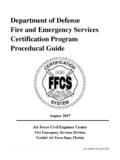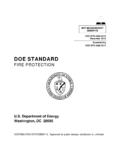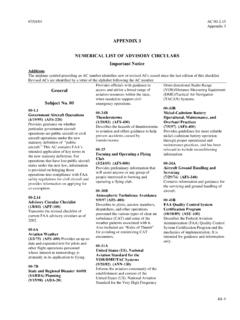Transcription of BY ORDER OF THE AIR FORCE INSTRUCTION 32-7086 …
1 BY ORDER OF THE SECRETARY OF THE AIR FORCE AIR FORCE INSTRUCTION 32-7086 4 FEBRUARY 2015 Civil Engineering HAZARDOUS MATERIALS MANAGEMENT COMPLIANCE WITH THIS PUBLICATION IS MANDATORY ACCESSIBILITY: Publications and forms are available on the e-Publishing website at for downloading or ordering. RELEASABILITY: There are no releasability restrictions on this publication. OPR: AF/A4CE Supersedes: AFI32-7086, 1 November 2004 Certified by: AF/A4CF (Mr. Robert M. Gill) Pages: 31 This INSTRUCTION implements Air FORCE Policy Directive (AFPD) 32-70, Environmental Quality, July 1994, and AFPD 90-8, Environmental, Safety and Occupational Health Management and Risk Management, 2 February, 2012. It also implements Executive ORDER (EO) 13423, Strengthening Federal Environmental, Energy, and Transportation Management, 26 January 2007, and EO 13514, Federal Leadership in Environmental, Energy, and Economic Performance, 8 October 2009.
2 This Air FORCE INSTRUCTION (AFI) does not substitute or supersede related areas of AFI 90-821, Hazard Communication. It establishes procedures and standards that govern identification, authorization, and tracking of hazardous materials (HAZMAT) at Air FORCE installations. This AFI applies at all Air FORCE installations worldwide regardless of whether the processes are performed by government or contractor personnel. However, for installations located in foreign countries the AFI only applies to the extent it does not conflict with the provisions of applicable international agreements, country- specific Final Governing Standards (FGS), the Overseas Environmental Baseline Guidance Document (OEBGD), Combatant Command policy, and/or the environmental considerations annex of an operation plan or directive (whichever applies).
3 It applies to Joint Bases where the Air FORCE is the lead (supporting) Service, unless superseded by the Joint Base memorandum of agreement. Ensure that all records created as a result of processes prescribed in this publication are maintained in accordance with Air FORCE Manual (AFMAN) 33-363, Management of Records, and disposed of in accordance with the Air FORCE Records Disposition Schedule located in the Air FORCE Records Information Management System ( ). Refer recommended changes and questions about this publication to the Office of Primary Responsibility (OPR) using the AF Form 847, Recommendation for Change of Publication; route AF Forms 847 from the field through the appropriate functional chain of command.
4 2 AFI32-7086 4 FEBRUARY 2015 Organizations may supplement this INSTRUCTION , to include the Air National Guard and Air FORCE Reserve Command (AFRC). Supplements must be routed to AF/A4C for coordination prior to certification and approval. Further, the ANG or AFRC, in coordination with AF/A4C, will support the intent of this AFI, but where needed may prepare an appropriate policy, supplement, guidance, and/or procedural document reflecting its unique legal status, resources, and structure, as recognized by the reserve component authorities of Title 10 of the United States Code, Air FORCE Doctrine and other governing authorities. This AFI prescribes AF Form 3952, Chemical/Hazardous Material Request/Authorization. Any proposed changes to content involving, material safety data sheets (MSDS), safety data sheets (SDS), and HAZCOM must be coordinated through AFMSA/SG3PB.
5 Note: SDSs will replace MSDSs by 1 June 2015. References in this document to "SDS" apply to both MSDS and SDS. The authorities to waive wing/unit level requirements in this publication are identified with a Tier ( T-0, T-1, T-2, T-3 ) number following the compliance statement. See AFI 33-360, Publications and Forms Management, for a description of the authorities associated with the Tier numbers. Submit requests for waivers through the chain of command to the appropriate Tier waiver approval authority, or alternately, to the Publication OPR for non-tiered compliance items. SUMMARY OF CHANGES This document is substantially revised and must be completely reviewed. This revision updates and replaces AFI 32-7086 , Hazardous Material Management, 1 Nov 2004, in its entirety.
6 This revised AFI connects the Hazardous Materials Management Process (HMMP) to the AF Environmental Management System (EMS). It introduces HAZMAT Tracking Activity (HTA) terminology to describe key aspects of the HAZMART function. It corrects references to laws and regulations, and clarifies the definition of HAZMAT at paragraph HMMP functional responsibilities are streamlined, but remain largely the same with an emphasis on collaboration. This AFI also eliminates the mandatory requirement for Major Command (MAJCOM) HMMP teams. A section has been added on HAZMAT management policy and guidance linkages to address Air FORCE Audit Agency findings. This revision complies with AFI 33-360 waiver tier requirements described above and incorporates revised roles and responsibilities based on Program Action Directive (PAD) 12-03, Enterprise-Wide Civil Engineer Transformation, and associated Programing Plan (P-Plan).
7 AF-specific policy remains in this AFI, however, additional and more detailed information can be found in the non-directive process HAZMAT management playbook published on the AF Civil Engineer (CE) Portal: Chapter 1 HAZARDOUS MATERIALS MANAGEMENT PROCESS (HMMP) OVERVIEW 4 HMMP Scope.. 4 HMMP Purpose.. 4 HMMP Objectives.. 4 HAZMAT Definition and Exceptions.. 5 AFI32-7086 4 FEBRUARY 2015 3 HMMP Teams.. 5 HAZMAT Tracking Activity (HTA).. 6 AF HAZMAT Guidance Linkages.. 6 Additional HMMP Guidance and Best Practices.. 6 Chapter 2 ROLES AND RESPONSIBILITIES 7 Headquarters Air FORCE (HAF) .. 7 The Air FORCE Civil Engineer Center, Environmental Directorate (AFCEC/CZ).. 10 MAJCOMs and Air National Guard Readiness Center (ANGRC).. 10 Installations.
8 12 Other Specialized Responsibilities.. 16 Chapter 3 INSTALLATION HAZMAT MANAGEMENT GUIDANCE AND PROCEDURES 17 Overview.. 17 HAZMART.. 17 HAZMAT Monitoring Process.. 18 HAZMAT Determination and Authorization Process.. 19 EESOH-MIS.. 20 Additional Installation-level HAZMAT Management Considerations.. 20 Attachment 1 GLOSSARY OF REFERENCES AND SUPPORTING INFORMATION 25 4 AFI32-7086 4 FEBRUARY 2015 Chapter 1 HAZARDOUS MATERIALS MANAGEMENT PROCESS (HMMP) OVERVIEW HMMP Scope. HAZMAT management responsibilities are distributed across the core AF functions of Acquisition, Logistics Readiness (Materiel Management), Maintenance, CE, Surgeon General (SG) (Bioenvironmental Engineering or BE), Safety (SE), and Contracting. Each of these functions remains responsible for its inherent HAZMAT management policies, standards, and procedures (see Linkages, paragraph ).
9 The HMMP coordinates these distributed functional activities and responsibilities to enable effective AF enterprise-wide HAZMAT management and oversight. To existing functional HAZMAT policies and procedures, the HMMP also adds specific cross-functional HMMP teaming, HAZMAT authorization, HAZMAT tracking, and ozone depleting substance (ODS) management requirements. HMMP Purpose. The HMMP is an essential element of the AF EMS, established in response to the requirements of EO 13423 (see AFI 32-7001, Environmental Management). It coordinates and integrates the AF activities and infrastructure required for the ongoing identification, authorization and tracking of HAZMAT. The purpose of the HMMP is to facilitate the management of the procurement and use of HAZMAT to: (1) support Air FORCE missions; (2) protect the safety and health of personnel on Air FORCE installations and communities surrounding Air FORCE installations by ensuring proper authorization of HAZMAT; (3) minimize Air FORCE use of HAZMAT consistent with mission requirements; and (4) maintain Air FORCE compliance with environmental requirements for HAZMAT usage.
10 HMMP Objectives. The HMMP accomplishes these purposes by coordinating the effective management and minimization of AF dependence on HAZMAT within acceptable levels of mission and ESOH risk, while reducing associated total ownership cost. The specific objectives of the HMMP are to: Establish a collaborative framework for collecting and maintaining HAZMAT data on the standardized Air FORCE HAZMAT tracking system. The Enterprise Environment, Safety, and Occupational Health Management Information System (EESOH-MIS) is the standardized Air FORCE HAZMAT and hazardous waste tracking system. Support compliance with applicable HAZMAT management laws, regulations and EOs, especially EO 13423 and EO 13514, which require federal agencies to comply with Emergency Planning and Community Right-to-Know Act (EPCRA) sections ( ) 301-313 and to minimize the use of HAZMAT.













